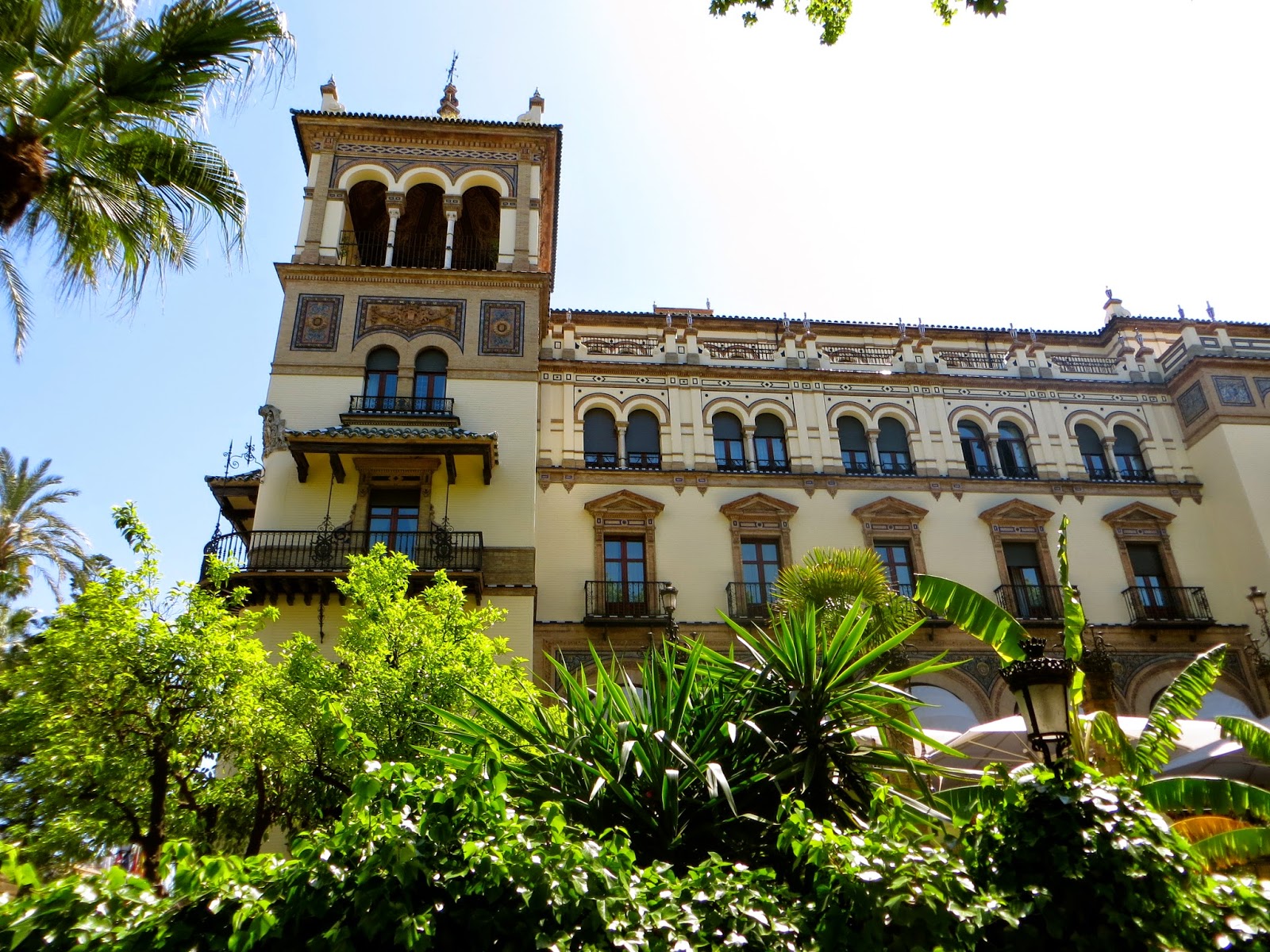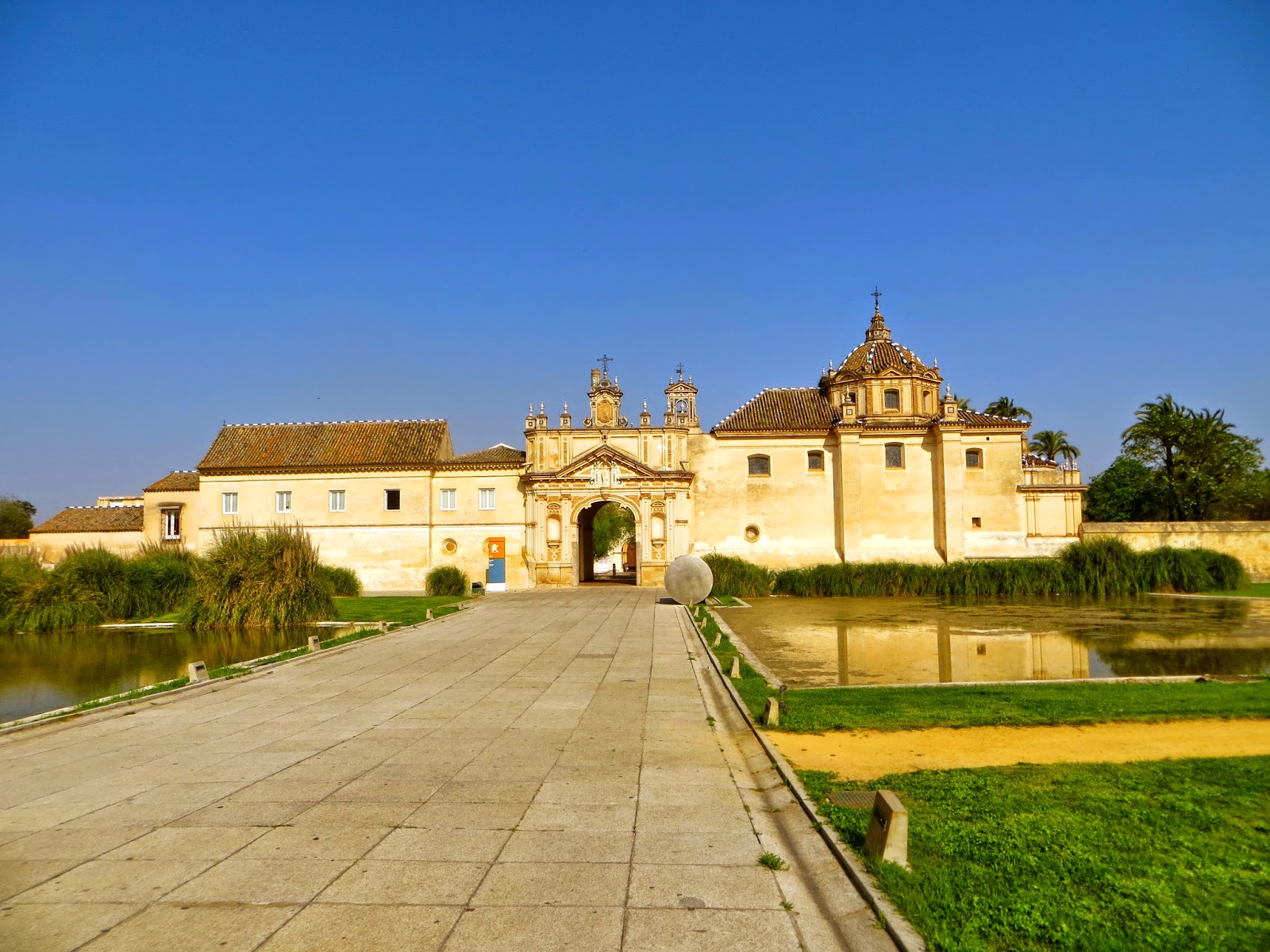Seville, the city that has a soul, flamenco and endless charm. After
spending a day in this beautiful city, I fell in love and was eager to see
more. Every inch of the city has something special to offer and provided
extreme amounts of Andalucían culture. Needless to say, it has been my favorite
city in Spain thus far.
This past Wednesday I hopped on an early train that put me
in Seville around noon. Since I was traveling solo, I spent the trip reading up
on the city and planning what sites I wanted to see each day. I always try and
make a plan, but it was especially important to have one this trip since I was
traveling alone. I stayed in
Hostel One Seville, which I highly recommend to all student
travelers, especially if you are traveling alone. Upon arrival the hostel provided
numerous activities I could sign up for in the evenings such as bar crawls and
flamenco shows. I did sign up for a flamenco show and rented a bike for the
following day.
After taking a minute to recover from my train ride I
ventured into the spectacular city center. I briefly saw the cathedral and
Alcazar before heading to towards Plaza de Espana. On the way I saw some
spectacular buildings such as the fancy Hotel Alfonso XIII, Portugal Consulate, and
the theatre of Seville. Plaza de Espana came out of now where and I was taken
aback by its size and beauty. It was built in 1929 for the international fair and is an amazing homage to all of Spain. A walk around the
semi-circle shows all these tile murals dedicated to each city in Spain. Each
mural tells a story, usually of how the city was founded or a significant
historical event. I found Almeria’s tile mural and it was a depiction of the
Christians taking over the city.
Across
from Plaza de Espana was the Maria Luisa gardens which were georgous and a perfect
place to eat lunch. To anyone that visits these gardens I recommend visiting
Plaza de America that consisted of beautiful rose gardens encompassed by some
beautiful museums.
 |
| Hotel Alonso XIII |
 |
| Plaza de Espana |
 |
| Plaza de Espana |
I picked a perfect time to travel to Seville because this
week was their second biggest fair, Feria de Abril. It always takes place a
couple weeks after Semana Santa and is a giant celebration. Women dress up in
flamenco outfits, men wear suits and horse carriages are everywhere
providing transportation to the fair goers. At the fair grounds there are
private tents that people party in from morning until late night, basically a
24 hour party. There are a couple tents open to the public, but I did not
venture inside since I was alone and looked like a complete tourist in my jean
shorts and tank top. The fair is also similar to a carnival or fall festival
with rides (some not up to American safety standards) and games. It was a fun
and lively atmosphere both during the day and night.
 |
| The men on their horses enjoying a refreshing drink! |
 |
| The private party tents |
 |
| Woman dressed in a tradition Flamenco dress |
 |
| Torre del Oro |
After the fair I headed to the neighborhood of Triana, where
my sister Courtney lived when she studied in Seville. I was hoping to go inside
some of its many pottery shops, but unfortunately they all closed early due to
Feria. After wondering the charming streets, I saw the Torre del Oro (home of the naval museum) and Plaza de
Torros then headed back to my hostel with gelato in hand.
That evening I headed to the flamenco show with other people
from my hostel. I actually met a guy from Fort Wayne, Indiana
who was stationed just a little outside of Seville with the army. The flamenco
show consisted of 4 people, two dancers, a singer and a guitar player. It was
completely unrehearsed since that is what the flamenco lifestyle is about. It
is supposed to be a dance of feeling and emotion from the soul rather than a
rehearsed routine. The woman's dance was amazing in the way she quickly moved her
feet to make a beat; it rivaled a tap dancer. At one point her earring flew off
because she was dancing so hard. It was a great taste of Sevillan culture.
The next morning I woke up early, hoped on my bike, and rode
to the north of the city to the Church of the Macarena. This church made my
list because it houses two of the main floats they use in the Semana Santa
parades, and is also home to the La Macarena or "Weeping Virgen", Seville's most popular image of Mary. Sculpted in the late 17th century, the doll has 5 crystal tear drops and an expression halfway between smiling and crying. The
church also has a museum that housed gigantic and extremely intricate floats used during the Semana Santa parade, such as Christ of the Judgement. During the actual parades 48 men
carry the three-ton float on their backs and shuffle through the streets from midnight to 2:00pm on Good Friday. The
neighborhood of the Macarena includes some of the old Roman walls that remain within
the city. And yes, this neighborhood is what the song “Macarena” is named
after, a dance that
I am extremely
good at.
 |
| The "Weeping Virgen" |
 |
La Macarena float used in parades during Semana Santa (1.5 tons)
|
 |
| Christ of the Judgement float |
Next on my was list was Seville’s cathedral, the third
biggest in Europe, and biggest gothic cathedral anywhere. I rode on the bike
trail from the which encompasses the whole city center and makes getting from point A to
B extremely easy. The cathedral was 3 euros with my student ID, and was
exceptionally
beautiful on the
inside. This cathedral has some interesting things that differentiate it from
other churches such as Christopher Columbus’s grave (since his body has been
moved so many times it is debatable whether that is his remains or not but a
DNA test in 2006 proved it is his remains), Spain's most valuable crown with the
largest pearl in the world, and the Giralda tower that provides a spectacular
view of the city. Before this cathedral was built a Mosque existed, but was then
tore down in 1401 and in its place this spectacular Catholic cathedral was built.
 |
| Most valuable crown in Spain |
 |
| The beautiful cathedral is behind me! |
Following the cathedral, I toured the old Jewish Quarter
known as the neighborhood of Santa Cruz. The streets in this area are so small
that cars cannot drive here. It is full of souvenir shops, precious plazas,
restaurants and courtyards adorned with flowers. This area of town is a place
to just roam and “get lost in”. Rather than getting lost by myself, I did the
self-guided tour in Rick Steve’s Spain book. It pointed out some cool buildings
and alleyways I would have not noticed otherwise.
Once
I had seen
most of the neighborhood, I ventured to the Church of the Savior to escape the
heat and was able to get in free with my ticket from the cathedral. This church
was adorned with ornate altar pieces, but was not dark and dim lit like most
other churches. I just sat in a pew and took in its magnificence for a little
while before biking to Plaza de Espana. I had time in
the day to kill and enjoyed this area so much that I decided to go back. After
returning to my hostel for a power nap, I took another bike ride on the
northeast side of the river in the technological park. This area was just like
it sounds, unattractive with nothing to see, but I did stumble upon the Museum
of Contemporary Art, which was a nice surprise in the middle of no where. Since
Seville has such nice bike trails, this bike ride was more for the experience
rather than specific sites I wanted to visit.
 |
| Museum of Contemporary Art |
 |
| The Cathedral at night |
Later that night my friends arrived in Seville (since we
left from Seville for Portugal the next morning). After eating gelato
(surprise, surprise) we headed towards the Feria de Abril to experience it at
night. During our walk we were able to experience the cathedral at night, which
was something every tourist should do. Lights from the surrounding buildings
light up the cathedral, giving it a magnificent glow. I am extremely jealous of
my sister Abby, who studied in Seville and had this as her backyard.
 |
| Feria from the Ferris Wheel |
Feria at night was a little more crazier than during
the day because young locals come and party. The private tents are carried into
the street and people of all ages are taking part in the festivities. After
riding the Ferris Wheel and some other rides, we decided to call it a night and
get some rest for Portugal.
Once the Portugal trip was over (that will be a separate
blog) we returned back to Seville for one more day and night. Monday morning we
awoke and headed towards the Real Alcazar, the royal palace that still houses
the King and Queen when they visit Seville. The Alcazar is the oldest palace in Europe still in use. It is special due to its Muedjar style, a mix between
Moorish and Christian. The intricate detail within all of the courtyards and
rooms was amazing. The arches and tile work spread through the entire palace
and into the gardens. I wish I had more time in the gardens due to their huge size
and pure beauty. I felt separated from the rest of the city with the beautiful
fountains, roses and peacocks roaming around, which is how I am sure the King
and Queen wanted it.
As you can tell from my extremely long blog, Seville was a
city to dedicate time to. The gardens and plazas made me fall in love with the
city, but its culture and charm make me want to return.
Tips:
1. Hostel One Seville is a great hostel. It is
reasonably priced, clean, provides activties and is about a 15 minute walk from
the cathedral.
2.
Three days and two nights is enough to see all
of the sites in Seville. Never rush however because Seville is a city to wander
around and take it all of its beauty.
3.
Dedicate about 2+ hours to the Real Alcazar and
about 1.5 hours to the Cathedral.
4.
Rent a bike if you can for a whole day because it
saves your feet from walking and gets you around the city quicker.
5.
If you want good Mexican food go to
Iguanas Ranas right next to the Alcazar.
6.
If you are traveling alone make an outline of
what sites you want to see each day. Nothing needs to be set in stone, but it
makes it easier to have a plan when traveling alone.

















Comments
Post a Comment